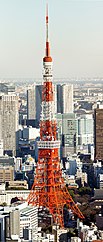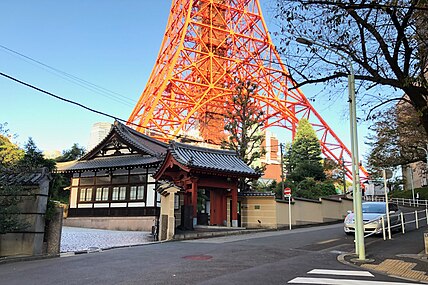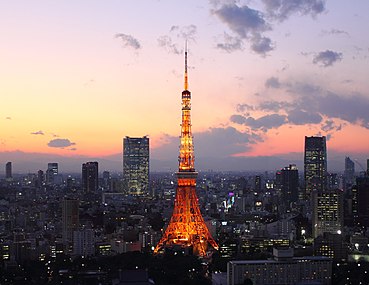Tokyo Tower
| Tokyo Tower | |
|---|---|
東京タワー | |
 | |
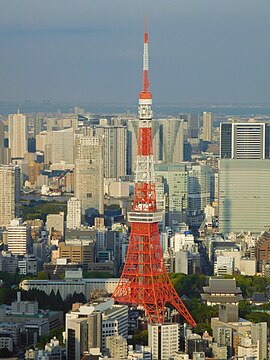 Tokyo Tower in 2023 | |
 | |
| General information | |
| Status | Completed |
| Type | Communications tower Observation tower |
| Location | 4-2-8 Shiba-koen, Minato, Tokyo 105-0011 |
| Coordinates | 35°39′31″N 139°44′44″E / 35.65861°N 139.74556°E |
| Construction started | June 1957 |
| Topped-out | 14 October 1958 |
| Completed | 1958 |
| Opening | 23 December 1958 |
| Cost | ¥2.8 billion (US$8.4 million in 1958) |
| Owner | The Tokyo Tower Company (controlling shareholder: Toei Company and Mother Farm) |
| Height | |
| Architectural | 333 m (1,093 ft) |
| Antenna spire | 332.9 m (1,092 ft)[2] |
| Top floor | 249.6 m (819 ft) |
| Observatory | 249.6 m (819 ft) |
| Technical details | |
| Floor count | 15 |
| Lifts/elevators | 4 |
| Design and construction | |
| Architect(s) | Tachū Naitō[1] |
| Structural engineer | Nikken Sekkei Ltd.[3] |
| Main contractor | Takenaka Corporation[1] |
| Website | |
| www | |
Tokyo Tower (東京タワー, Tōkyō Tawā, pronounced [toːkʲoː taɰᵝaː] ), officially Japan Radio Tower (日本電波塔, Nippon denpatō) is a communications and observation tower in the district of Shiba-koen in Minato, Tokyo, Japan, completed in 1958. At 332.9 meters (1,092 ft), it was the tallest tower in Japan until the construction of Tokyo Skytree in 2012. It is a lattice tower inspired by the Eiffel Tower, and is painted white and international orange to comply with air safety regulations.
The tower's main sources of income are tourism and antenna leasing. FootTown, a four-story building directly under the tower, houses museums, restaurants, and shops. Departing from there, guests can visit two observation decks. The two-story Main Deck (formerly known as the Main Observatory) is at 150 meters (490 ft), while the smaller Top Deck (formerly known as the "Special Observatory") reaches a height of 249.6 meters (819 ft). The names were changed following renovation of the top deck in 2018.[4] The tower is repainted every five years, taking a year to complete the process.
In 1961, transmission antennae were added to the tower. They are used for radio and television broadcasting and now broadcast signals for Japanese media outlets such as NHK, TBS Television, and Fuji Television. The height of the tower was not suitable for Japan's planned terrestrial digital broadcasting planned for July 2011, and for the Tokyo area. A taller digital broadcasting tower, known as Tokyo Skytree, was completed on 29 February 2012. Tokyo Tower has become a prominent landmark in the city, and frequently appears in media set in Tokyo.
Construction
[edit]A large broadcasting tower was needed in the Kantō region after NHK, Japan's public broadcasting station, began television broadcasting in 1953. Private broadcasting companies began operating in the months following the construction of NHK's own transmission tower. This communications boom led the Japanese government to believe that transmission towers would soon be built all over Tokyo, eventually overrunning the city. The proposed solution was the construction of one large tower capable of transmitting to the entire region.[5] Furthermore, because of the country's postwar boom in the 1950s, Japan was searching for a monument to symbolize its national recovery from World War II, as one of the countries most ravaged by the war.[6][7]
Hisakichi Maeda, founder and president of Nippon Denpatō, the tower's owner and operator, originally planned for the tower to be taller than the Empire State Building, which at 381 meters was the highest structure in the world at the time. However, the plan fell through because of the lack of both funds and materials. The tower's height was eventually determined by the distance the TV stations needed to transmit throughout the Kantō region, a distance of about 150 kilometers (93 mi).[5]
Tachū Naitō, renowned designer of tall buildings in Japan, was chosen to design the newly proposed tower.[5] Looking to the Western world for inspiration, Naitō based his design on the Eiffel Tower in Paris, France.[8] With the help of engineering company Nikken Sekkei Ltd., Naitō claimed his design could withstand earthquakes with twice the intensity of the 1923 Great Kantō earthquake or typhoons with wind speeds of up to 220 kilometers per hour (140 mph).[5]
The new construction project attracted hundreds of tobi (鳶), traditional Japanese construction workers who specialized in the construction of high-rise structures. The Takenaka Corporation broke ground in June 1957 and each day at least 400 laborers worked on the tower.[5] It was constructed of steel, a third of which was scrap metal taken from US tanks damaged in the Korean War.[9][10] When the 90-meter-long antenna was bolted into place on 14 October 1958, Tokyo Tower was the tallest freestanding tower in the world, taking the title from the Eiffel Tower by nine meters.[11][failed verification]
Though it is taller than the Eiffel Tower, Tokyo Tower weighs about 4,000 tons, 3,300 less than the Eiffel Tower.[12] It was opened to the public on 23 December 1958 at a final cost of ¥2.8 billion ($8.4 million in 1958).[10][13] Tokyo Tower was mortgaged for ¥10 billion in 2000.[14] It was the tallest artificial structure in Japan until April 2010, when it was surpassed by the Tokyo Skytree.[8]
Planned as an antenna for telecommunications and brightly colored in accordance with the time's Aviation Law, the tower's two panoramic observatories are mostly frequented by tourists today. The tower constitutes a clear reference point in the center's skyline, forming a strong landmark, both night and day.[15] Every five years, the tower is repainted in a process that takes about a year to complete. Tokyo Tower is next planned to be repainted in 2024.[16][17]
Functions
[edit]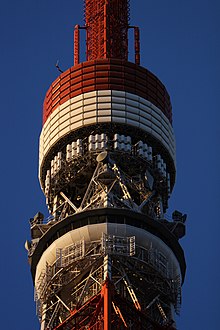
Tokyo Tower's two main revenue sources are antenna leasing and tourism. It functions as a radio and television broadcasting antenna support structure and is a tourist destination that houses several different attractions. The tower recorded its 190 millionth visitor in 2024.[18] Visitor numbers had been steadily declining, bottoming out at 2.3 million in 2000[19] before rising since then.[7]
The first area tourists visit upon reaching the tower is FootTown, a four-story building stationed directly under the tower. There, visitors can eat, shop, and visit several museums and galleries. Elevators that depart from the first floor of FootTown can be used to reach the first of two observation decks, the two-story Main Observatory.[20] For the price of another ticket, visitors can board another set of elevators from the second floor of the Main Observatory to reach the final observation deck—the Special Observatory.[21]
Broadcasting
[edit]
Tokyo Tower, a member of the World Federation of Great Towers, has been used by many organizations for broadcasting purposes. The structure was intended for broadcasting television, but radio antennas were installed in 1961 because it could accommodate them.[7] While analog and digital television broadcasts are no longer conducted from the site, two FM radio stations remain on Tokyo Tower. Stations that use or have used the tower's antenna include:[12]
Current
[edit]Former
[edit]- NHK General TV Tokyo (JOAK-TV): VHF Channel 1 (Analog)
- NHK Educational TV Tokyo (JOAB-TV): VHF Channel 3 (Analog)
- Nippon Television Tokyo (JOAX-TV): VHF Channel 4 (Analog)
- Tokyo Broadcasting System Television (JORX-TV): TBS Television/VHF Channel 6 (Analog)
- Fuji Television Tokyo (JOCX-TV): Fuji Television Analog/VHF Channel 8 (Analog)
- TV Asahi Tokyo (JOEX-TV): TV Asahi Analog Television/VHF Channel 10 (Analog)
- TV Tokyo (JOTX-TV): VHF Channel 12 (Analog)
- Tokyo Metropolitan Television (JOMX-TV): UHF Channel 14 (Analog)
- The University of the Air TV (JOUD-TV): UHF Channel 16 (Analog)
- tvk (JOKM-TV): UHF Channel 42 (Analog)
- The University of the Air-FM (JOUD-FM): 77.1 MHz
- J-Wave (JOAV-FM): 81.3 MHz
- NHK Radio FM Tokyo (JOAK-FM): 82.5 MHz
Japan employs both analog and digital broadcasting. In July 2011 all television broadcasting was changed to solely digital. Tokyo Tower is not a reliable broadcasting antenna for completely digital broadcasting because the tower is not tall enough to transmit the higher frequency waves to areas surrounded by forests or high-rise buildings. As an alternative, a new 634-meter-tall (2,080 ft) tower called the Tokyo Skytree was opened in 2012.[7] In an attempt to make Tokyo Tower more appealing to NHK and the five other commercial broadcasters who planned to move their transmitting stations to the new tower, Nihon Denpatō officials drafted a plan to extend its digital broadcasting antenna by 80 to 100 meters at a cost of approximately ¥4 billion (US$50 million).[22]
As a result of their move to the Skytree, only one digital television station remained on Tokyo Tower: that of the Open University of Japan, whose JOUD-DTV and JOUD-FM continued on the tower until shutting down in 2018. FM radio stations will continue to use the tower for broadcasting in the Tokyo area. Masahiro Kawada, the tower's planning director, raised the possibility of the tower becoming a backup for the Tokyo Skytree, depending on what the TV broadcasters want or need.[7][23]
The antenna's tip was damaged on 11 March 2011 by the Tōhoku earthquake.[24] On 19 July 2012, Tokyo Tower's height shrank to 315 meters while the top antenna was repaired for damage from the earthquake.[2]
Attractions
[edit]FootTown
[edit]
Located in the base of the tower is a 4-story building known as FootTown. The first floor includes the Aquarium Gallery, a reception hall, the 400-person-capacity "Tower Restaurant", a FamilyMart convenience store and a souvenir shop.[25][26] This floor's main attractions, however, are the three elevators that serve as a direct ride to the Main Observatory.[20] The second floor is primarily a food and shopping area. In addition to the five standalone restaurants, the second floor's food court consists of four restaurants, including a McDonald's and a Pizza-La.[27][28]

FootTown's third and fourth floors house several tourist attractions. The third floor is home to the Guinness World Records Museum Tokyo, a museum that houses life-size figures, photo panels and memorabilia depicting interesting records that have been authenticated by the Guinness Book.[29] The Tokyo Tower Wax Museum, opened in 1970, displayed wax figures imported from London where they were made[30] until it was closed in 2013.[31]
The figures on display range from pop culture icons such as The Beatles to religious figures such as Jesus Christ. A hologram gallery named the Gallery DeLux, a lounge and a few specialty stores are also located on this floor.[32] Tokyo Tower's Trick Art Gallery is located on the building's fourth and final floor. This gallery displays optical illusions, including paintings and objects that visitors can interact with.[33]
On the roof of the FootTown building is a small amusement park that contains several small rides and hosts live performances for children.[34] On weekends and holidays, visitors can use the roof to access the tower's outside stairwell. At approximately 660 steps, the stairwell is an alternative to the tower's elevators and leads directly to the Main Observatory.[35]
Tokyo One Piece Tower
[edit]Based on the hit manga and anime One Piece, Tokyo Tower featured a small One Piece themed amusement park that opened in 2015 and closed in 2020. The amusement park offered a range of attractions, shops, and restaurants, all based on the characters from Eiichiro Oda's manga. Patrons enjoyed various games or attractions based on their favorite characters and enjoyed meals from the world of One Piece. There was a gift store that features exclusive goods for One Piece fans.[36][37]
Appearance
[edit]
Tokyo Tower requires 28,000 liters (7,400 U.S. gal) of paint to completely paint the structure white and international orange, complying with air safety regulations.[12] Before the tower's 30th anniversary in 1987, the only lighting on the tower were light bulbs located on the corner contours that extended from the base to the antenna. In the spring of 1987, Nihon Denpatō invited lighting designer Motoko Ishii to visit the tower. Since its opening 30 years earlier, the tower's annual ticket sales had dropped significantly, and in a bid to revitalize the tower and again establish it as an important tourist attraction and symbol of Tokyo, Ishii was hired to redesign Tokyo Tower's lighting arrangement.[38]
Unveiled in 1989, the new lighting arrangement required the removal of the contour-outlining light bulbs and the installation of 176 floodlights in and around the tower's frame.[38] From dusk to midnight, the floodlights illuminate the entire tower.[12] Sodium vapor lamps are used from 2 October to 6 July to cover the tower in an orange color. From 7 July to 1 October, the lights are changed to metal halide lamps to illuminate the tower with a white color. The reasoning behind the change is a seasonal one. Ishii reasoned that orange is a warmer color and helps to offset the cold winter months. Conversely, white is thought a cool color that helps during the hot summer months.[39]
Occasionally, Tokyo Tower's lighting is changed to specific arrangements for special events. The tower is specially lit for some annual events. Since 2000, the entire tower has been illuminated in a pink light on 1 October to highlight the beginning of National Breast Cancer Awareness Month. The tower has also had a variety of special lighting arrangements for Christmas since 1994. During New Year's Eve, the tower lights up at midnight with a year number displayed on one side of the observatory to mark the arrival of the new year.[39]
Special Japanese events have been cause to light the tower in several non-traditional ways. In 2002, alternating sections of the tower were lit blue to help celebrate the opening of the FIFA World Cup in Japan. Alternating sections of the tower were lit green on Saint Patrick's Day in 2007 to commemorate the 50th anniversary of Japanese–Irish relations. On a few occasions, Tokyo Tower has even been specially lit to correspond with corporate events. For example, the top half of the tower was lit green to correspond with the Japanese premiere of The Matrix Reloaded and different sections of the tower were lit red, white and black to commemorate the first day of sales of Coca-Cola C2.[39]
The tower was lit for the new millennium in 2000 with Motoko Ishii again reprising her role as the designer.[40] In December 2008, Nihon Denpatō spent $6.5 million to create a new night-time illumination scheme—titled the "Diamond Veil"—to celebrate the tower's 50th anniversary. The arrangement featured 276 lights in seven colors equally distributed across the towers four faces.[10]
When employing specialty lighting on the tower, the Main Observatory often plays an important role. During the second international "White Band Day" on 10 September 2005, the tower was completely unlit except for the Main Observatory, which was lit with a bright white light. The resulting white ring represented the White Band referenced in the day's name. The two floors of windows that make up the exterior of the Main Observatory are utilized to display words or numbers. When the tower employed lighting to commemorate terrestrial digital broadcasting first being available in the Kantō region on 1 December 2005, each side of the Main Observatory displayed the characters 地デジ (chi deji, an abbreviation for 地上デジタル放送 chijō dejitaru hōsō terrestrial digital broadcasting).[39] More recently, the observatory displayed both "TOKYO" and "2016" to stress Tokyo's 2016 Olympic bid.[41] Primitive images, such as hearts, have also been displayed using the observatory's windows.[39]

-
Tokyo Tower, with Shiodome in the background
-
The tower's original lighting arrangement, used until 1989
Renovation
[edit]Operations at the Tokyo Tower Top Deck (at the height of 250 m) were suspended in 2016. The Top Deck reopened on March 3, 2018. At that time, Tokyo Tower also announced the renaming of both decks. Renovations on the main deck, which began in September 2016, caused partial closure of the deck.[4]
Mascots
[edit]The Tokyo Tower has two mascots named ノッポン Noppon. They are two brothers: Older Brother, who wears blue dungarees, and Younger Brother, who wears red dungarees. They were unveiled on 23 December 1998 to celebrate the 40th anniversary of Tokyo Tower.[42]
Media representation
[edit]Just as the Eiffel Tower is often used in popular culture to immediately locate a scene in Paris, Tokyo Tower is often used in the same way for Tokyo.
It is used in anime and manga such as Doraemon, Tokyo Magnitude 8.0, Magic Knight Rayearth, Please Save My Earth, Cardcaptor Sakura, Digimon, Detective Conan, Sailor Moon, Tenchi Muyo! and Death Note.[43] The tower is frequently used in the Japanese kaiju (giant monster) film genre. It has been the location of numerous battles and visitations by Godzilla, Mothra, Gamera and King Kong (King Kong Escapes) wherein it is frequently destroyed and rebuilt.[13][44]
Based on the popular manga series by Ryōhei Saigan, the 2005 film Always Sanchōme no Yūhi was a nostalgic view of life in the neighborhoods beneath the construction ofTokyo Tower. In the 2022 film Bubble, it is depicted as being destroyed by the titular reality-breaking bubbles.
Gallery
[edit]-
Shinkōin and the base of Tokyo Tower
-
Aerial view on Shiba-koen at dusk
-
Tokyo Tower at sunset
-
Tokyo Tower at night from Roppongi hills
-
Tokyo Tower at night
-
Tokyo Tower during a snowfall in 2018
-
Summer night in 2008
See also
[edit]- Nagoya TV Tower
- Sapporo TV Tower
- Media of Japan
- List of tallest freestanding structures
- List of tallest freestanding steel structures
- List of tallest towers
- List of transmission sites
- Lattice tower
Notes
[edit]References
[edit]- ^ a b "Tokyo Tower". Emporis. Archived from the original on 11 June 2004. Retrieved 11 April 2008.
{{cite web}}: CS1 maint: unfit URL (link) - ^ a b "Tokyo Tower gets shorter for the 1st time". Retrieved 23 July 2012.
- ^ "Structural Engineering". Nikken Sekkei. Archived from the original on 21 April 2008. Retrieved 11 April 2008.
- ^ a b "Grand opening of Tokyo Tower's Top Deck (250 m), and Main Deck (150 m) renovation. | TokyoTower". www.tokyotower.co.jp. Retrieved 18 July 2018.
- ^ a b c d e Gilhooly, Rob (17 March 2002). "The tower and the story". The Japan Times. Retrieved 11 November 2013.
- ^ Bruan, Stuart. "Big in Japan:Tokyo Tower". Metropolis. Archived from the original on 10 June 2008. Retrieved 21 September 2008.
- ^ a b c d e Ito, Masami (30 December 2008). "Half century on, Tokyo Tower still dazzles as landmark". The Japan Times. Retrieved 21 January 2009.
- ^ a b "Tokyo Tower 東京タワー". SkyscraperPage. Retrieved 29 March 2008.
- ^ 鉄の豆知識 (in Japanese). Otani Steel Corporation. Retrieved 30 March 2008.
- ^ a b c Fackler, Martin (30 December 2008). "Tokyo Tower goes from futuristic hope to symbol of the good old days". International Herald Tribune. Retrieved 21 January 2009.
- ^ "The Eiffel Tower at a glance". 30 October 2017. Retrieved 25 April 2019.
- ^ a b c d "Tokyo Tower Data". Nippon Television City Corporation. Archived from the original on 30 April 2008. Retrieved 29 March 2008.
- ^ a b "Tokyo Tower vs. Super Tower: Crossed Signals?" (PDF). Colliers International. October 2005. Archived from the original (PDF) on 12 June 2009. Retrieved 21 January 2009.
- ^ Alex Vega (7 July 2006). "The Small Print". Metropolis. Archived from the original on 24 February 2008. Retrieved 30 March 2008.
- ^ Sacchi, Livio (2004). Tokyo City and Architecture. Skira Editore S.p.A. p. 58. ISBN 88-8491-990-8.
- ^ "5年に1回のお化粧直し。" (in Japanese). Archived from the original on 26 September 2013. Retrieved 2 August 2013.
- ^ "Tokyo Tower". Archived from the original on 6 October 2013. Retrieved 2 August 2013.
- ^ "Tokyo Tower marks 190 mil. visitors since opening 66 years ago". NHK World Japan. 4 September 2024. Retrieved 19 September 2024.
- ^ Sato, Shigemi (23 December 2008). "Tokyo Tower turns 50 with big party". Associated Press. Archived from the original on 7 February 2009. Retrieved 21 January 2009.
- ^ a b "Foot Town 1F". Nippon Television City Corporation. Archived from the original on 12 April 2008. Retrieved 1 April 2008.
- ^ "View from the Observatory". Nippon Television City Corporation. Archived from the original on 11 April 2008. Retrieved 1 April 2008.
- ^ "Tokyo Tower to add 100 meters". The Japan Times. 23 September 2007. Retrieved 18 September 2008.
- ^ Arpon, Yasmin Lee (22 March 2012). "Tokyo Skytree: A towering symbol". AsiaOne. Archived from the original on 22 March 2012. Retrieved 9 April 2012.
[Tokyo Skytree] will serve as the new broadcasting facility for six terrestrial broadcasters headed by NHK. Tokyo Tower, which stands at 333m…
- ^ "Tokyo Tower antenna bent, tourists evacuate via stairs". Jiji Press (in Japanese). Archived from the original on 25 October 2014.
- ^ "Aquarium gallery". Nippon Television City Corporation. Archived from the original on 15 April 2008. Retrieved 1 April 2008.
- ^ "Tower Restaurant". Nippon Television City Corporation. Archived from the original on 15 April 2008. Retrieved 1 April 2008.
- ^ "FoodCourt". Nippon Television City Corporation. Archived from the original on 15 April 2008. Retrieved 1 April 2008.
- ^ "Foot Town 2F". Nippon Television City Corporation. Archived from the original on 12 April 2008. Retrieved 1 April 2008.
- ^ "Guinness World Records Museum Tokyo". Nippon Television City Corporation. Archived from the original on 15 April 2008. Retrieved 1 April 2008.
- ^ "Wax Museum". Nippon Television City Corporation. Archived from the original on 15 April 2008. Retrieved 1 April 2008.
- ^ "In Writing Audio Video Galleries Events Magazine Subscribe Shop AboutAdvertisingContactNewsletter Subscriber Log In Tokyo Tower Wax Museum closing: Future uncertain for Zappa, Göttsching, and Faust waxworks". The Wire. 22 July 2013. Retrieved 22 June 2023.
- ^ "Foot Town 3F". Nippon Television City Corporation. Archived from the original on 15 April 2008. Retrieved 1 April 2008.
- ^ "Trick Art Gallery". Nippon Television City Corporation. Archived from the original on 15 April 2008. Retrieved 1 April 2008.
- ^ "Amusement Park". Nippon Television City Corporation. Archived from the original on 15 April 2008. Retrieved 1 April 2008.
- ^ "Direct staircase to the Main Observatory (Starting Point)". Nippon Television City Corporation. Archived from the original on 31 August 2007. Retrieved 1 April 2008.
- ^ "Tokyo One Piece Tower". One Piece Tower. Archived from the original on 3 June 2017. Retrieved 30 May 2017.
- ^ "Tokyo One Piece Tower". Japan Deluxe Tours. Retrieved 30 May 2017.
- ^ a b "⑤起死回生のライトアップ". Yomiuri Shimbun (in Japanese). 6 January 2008. Archived from the original on 11 March 2010. Retrieved 19 September 2008.
- ^ a b c d e 特別ライトアップ (in Japanese). 日本電波塔. Archived from the original on 26 April 2008. Retrieved 29 March 2008.
- ^ "Works". Motoko Ishii. Archived from the original on 26 September 2008. Retrieved 19 September 2008.
- ^ "TOKYO 2016 Lights Up the Tokyo Night". Japanese Olympic Committee. 29 November 2007. Archived from the original on 12 April 2008. Retrieved 20 September 2008.
- ^ Tokyo Tower English Archived 10 April 2008 at the Wayback Machine, NOPPONs' Secret
- ^ Dong, Bamboo (17 September 2007). "Crashing Japan". Anime News Network. Retrieved 23 February 2009.
- ^ Krafsur, Richard P.; Munden, Kenneth W. (1997). The American Film Institute Catalog of Motion Pictures Produced in the United States: Feature Films, 1961–1970. University of California Press. p. 578. ISBN 0-520-20970-2.



